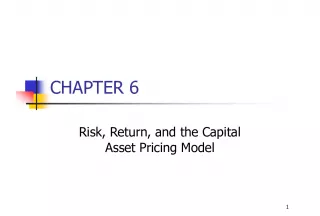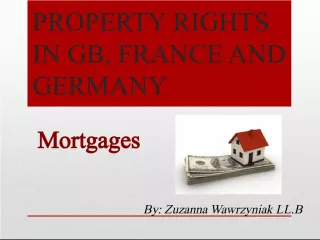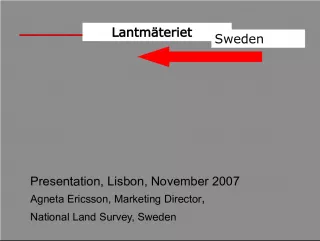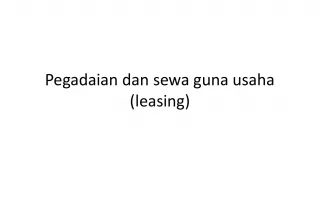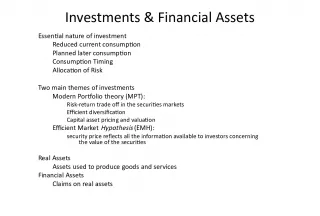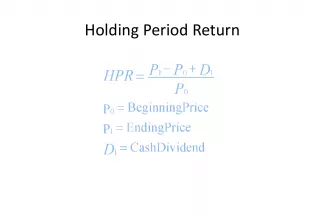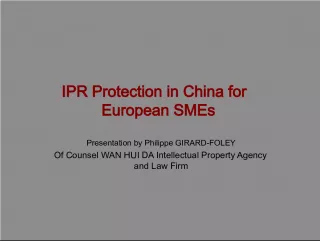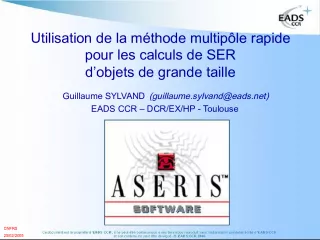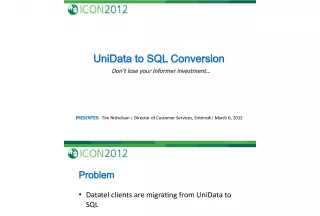Investment Property IAS 40 Presentation


An overview of IAS 40 Investment Property including definitions, recognition, measurement, disclosures, exercises, questions, disposal, and transfers. Covers carrying amount, cost, and fair value.
- Uploaded on | 1 Views
-
 susanne
susanne
About Investment Property IAS 40 Presentation
PowerPoint presentation about 'Investment Property IAS 40 Presentation'. This presentation describes the topic on An overview of IAS 40 Investment Property including definitions, recognition, measurement, disclosures, exercises, questions, disposal, and transfers. Covers carrying amount, cost, and fair value.. The key topics included in this slideshow are . Download this presentation absolutely free.
Presentation Transcript
Slide1Investment propertyIAS 40 LACPA IFRS Presentation
Slide22Overview of session 1. Introduction – definitions 2. Recognition 3. Measurement 6. Disclosures 7. Exercises 8. Questions 5. Disposal 4. Transfers
Slide3Investment property1. Introduction – definitions
Slide44Definitions – Carrying amount is the amount at which an asset is recognised in the balance sheet. – Cost is the amount of cash or cash equivalents paid or the fair value of other consideration given to acquire an asset at the time of its acquisition or construction. – Fair value is the amount for which an asset could be exchanged between knowledgeable, willing parties in an arm’s length transaction.
Slide55Definitions – Investment property is property (land or a building—or part of a building—or both) held (by the owner or by the lessee under a finance lease) to earn rentals or for capital appreciation or both, rather than for: a) use in the production or supply of goods or services or for administrative purposes; or b) sale in the ordinary course of business. – Owner-occupied property is property held (by the owner or by the lessee under a finance lease) for use in the production or supply of goods or services or for administrative purposes.
Slide66Definitions • A property interest that is held by a lessee under an operating lease may be classified and accounted for as investment property if, and only if, the property would otherwise meet the definition of an investment property and the lessee uses the fair value model for the asset recognised. – This classification alternative is available on a property- by-property basis. However, once this classification alternative is selected for one such property interest held under an operating lease, all property classified as investment property shall be accounted for using the fair value model and all required disclosures should be made.
Slide77Definitions Property description Meets definition of investment property Owned by the company and leased out under an operating lease Held under a finance lease and leased out under an operating lease Held under a finance lease and to be leased out in the future under an operating lease Held under a finance lease and leased out under a finance lease Owned by the company and leased out under a finance lease Owner-occupied property used in the production or supply of goods, services or for administrative purposes Held for sale in the ordinary course of business Held under operating lease A property comprising a piece of land and a building constructed on it leased out to a third party Property partly owner-occupied and partly leased out under an operating lease
Slide88Definitions Property description Meets definition of investment property Owned by the company and leased out under an operating lease Held under a finance lease and leased out under an operating lease Held under a finance lease and to be leased out in the future under an operating lease Held under a finance lease and leased out under a finance lease Owned by the company and leased out under a finance lease Owner-occupied property used in the production or supply of goods, services or for administrative purposes Held for sale in the ordinary course of business Held under operating lease A property comprising a piece of land and a building constructed on it leased out to a third party operating lease, unless expected to pass to lessee at end of lease Property partly owner-occupied and partly leased out under an operating lease the 2 portions accounted for separately if they can be sold separately; if not, to be treated as PPE, unless the owner-occupied portion is insignificant.
Slide9Investment property2. Recognition
Slide1010Recognition • Investment property shall be recognised as an asset when, and only when: a) it is probable that the future economic benefits that are associated with the investment property will flow to the entity; and b) the cost of the investment property can be measured reliably.
Slide11Investment property3. Measurement
Slide1212Measurement Initial measurement • An investment property shall be measured initially at its cost. Transaction costs shall be included in the initial measurement. • The initial cost of a property interest held under a lease and classified as an investment property shall be as prescribed for a finance lease, i.e. the asset shall be recognised at the lower of the fair value of the property and the present value of the minimum lease payments. An equivalent amount shall be recognised as a liability.
Slide1313Measurement Subsequent measurement • An entity can choose as its accounting policy either the fair value model or the cost model and shall apply that policy to all of its investment property. • After initial recognition, an entity that chooses the fair value model shall measure all of its investment property at fair value, except for when the fair value of the investment property is not reliably determinable on a continuing basis. This arises when, and only when, comparable market transactions are infrequent and alternative reliable estimates of fair value are not available. Then, an entity shall measure that investment property using the cost model in IAS 16. The residual value shall be assumed to be zero. The entity shall apply IAS 16 until disposal of the asset.
Slide1414Measurement Subsequent measurement • When a property interest held by a lessee under an operating lease is classified as an investment property, treatment is not elective. The fair value model is to be applied. • A gain or loss arising from a change in the fair value of investment property shall be recognised in profit or loss for the period in which it arises. • The fair value of investment property shall reflect market conditions at the balance sheet date.
Slide1515Measurement Subsequent measurement • If an entity has previously measured an investment property at fair value, it shall continue to measure the property at fair value until disposal (or until the property becomes owner-occupied property or the entity begins to develop the property for subsequent sale in the ordinary course of business) even if comparable market transactions become less frequent or market prices become less readily available. • If an entity chooses the cost model, it shall measure all of its investment property in accordance with IAS 16’s requirements.
Slide16Investment property4. Transfers
Slide1717Transfers • Transfers to, or from, investment property shall be made when, and only when, there is a change in use, evidenced by: a) commencement of owner-occupation, for a transfer from investment property to owner-occupied property; b) commencement of development with a view to sale, for a transfer from investment property to inventories; c) end of owner-occupation, for a transfer from owner-occupied property to investment property;
Slide1818Transfers d) commencement of an operating lease to another party, for a transfer from inventories to investment property; or e) end of construction or development, for a transfer from property in the course of construction or development (covered by IAS 16) to investment property.
Slide1919Transfers
Slide2020Transfers
Slide21Investment property5. Disposals
Slide2222Disposals • An investment property shall be derecognised (eliminated from the balance sheet) on disposal or when the investment property is permanently withdrawn from use and no future economic benefits are expected from its disposal. • Gains or losses arising from the retirement or disposal of investment property shall be determined as the difference between the net disposal proceeds and the carrying amount of the asset and shall be recognised in profit or loss in the period of the retirement or disposal. • Compensation from third parties for investment property that was impaired, lost or given up shall be recognised in profit or loss when the compensation becomes receivable.
Slide23Investment property5. Disclosures
Slide2424Disclosures Fair Value Model and Cost model • An entity shall disclose: a) whether it applies the fair value model or the cost model. b) if it applies the fair value model, whether, and in what circumstances, property interests held under operating leases are classified and accounted for as investment property. c) when classification is difficult, the criteria it uses to distinguish investment property from owner-occupied property and from property held for sale in the ordinary course of business.
Slide2525Disclosures Fair Value Model and Cost model d) the methods and significant assumptions applied in determining the fair value of investment property. e) the extent to which the fair value of investment property is based on a valuation by an independent valuer. If there has been no such valuation, that fact shall be disclosed. f) the amounts recognised in profit or loss for: i. rental income from investment property; ii. direct operating expenses (including repairs and maintenance) arising from investment property that generated rental income during the period; and
Slide2626Disclosures Fair Value Model and Cost model f) the amounts recognised in profit or loss for (continued): iii. direct operating expenses (including repairs and maintenance) arising from investment property that did not generate rental income iv. the cumulative change in fair value recognised in profit or loss on a sale of investment property g) the existence and amounts of restrictions on the realisability of investment property or the remittance of income and proceeds of disposal. h) contractual obligations to purchase, construct or develop investment property or for repairs, maintenance or enhancements.
Slide2727Disclosures Fair Value Model • In addition to the common disclosures, an entity that applies the fair value model shall disclose a reconciliation between the carrying amounts of investment property at the beginning and end of the period, showing : a) additions, disclosing separately those additions resulting from acquisitions and those resulting from subsequent expenditure recognised in the carrying amount; b) additions resulting from acquisitions through business combinations; c) assets classified or included in a disposal group classified as held for sale; d) net gains or losses from fair value adjustments; e) the net exchange differences arising on translation of financial statements into a different presentation currency, and on translation of a foreign operation into the presentation currency of the reporting entity; f) transfers to and from inventories and owner-occupied property; and g) other changes.
Slide2828Disclosures Fair Value Model • When a valuation obtained for investment property is adjusted significantly for the purpose of the financial statements, the entity shall disclose a reconciliation between the valuation obtained and the adjusted valuation included in the financial statements, showing separately and any significant adjustments.
Slide2929Disclosures Fair Value Model • In exceptional cases, when an entity can only measure investment property using the cost model in IAS 16, the reconciliation shall disclose amounts relating to that investment property separately from amounts relating to other investment property. Plus, an entity shall disclose: a) a description of the investment property; b) an explanation of why fair value cannot be determined reliably; c) if possible, the range of estimates within which fair value is highly likely to lie; and
Slide3030Disclosures Fair Value Model d) on disposal of investment property not carried at fair value: i. the fact that the entity has disposed of investment property not carried at fair value; ii. the carrying amount of that investment property at the time of sale; and iii. the amount of gain or loss recognised.
Slide3131Disclosures Cost Model • In addition to the common disclosures, an entity shall disclose: a) the depreciation methods used; b) the useful lives or the depreciation rates used; c) the gross carrying amount and the accumulated depreciation (aggregated with accumulated impairment losses) at beginning and end of the period; d) a reconciliation of the carrying amount of investment property at the beginning and end of the period, showing the following: i. additions, disclosing separately those additions resulting from acquisitions and those resulting from subsequent expenditure recognised as an asset; ii. additions resulting from acquisitions through business combinations;
Slide3232Disclosures Cost Model d) a reconciliation of the carrying amount of investment property at the beginning and end of the period, showing the following: iii. assets classified as held for sale or included in a disposal group classified as held for sale in accordance with IFRS 5 and other disposals; iv. depreciation; v. the amount of impairment losses recognised, and the amount of impairment losses reversed, during the period in accordance with IAS 36; vi. the net exchange differences arising on the translation of the financial statements into a different presentation currency, and on translation of a foreign operation into the presentation currency of the reporting entity; vii. transfers to and from inventories and owner-occupied property; and viii. other changes; and
Slide3333Disclosures Cost Model e) the fair value of investment property. In the exceptional cases, when an entity can only use the cost model because it cannot determine the fair value of the investment property reliably, it shall disclose: i. a description of the investment property; ii. an explanation of why fair value cannot be determined reliably; and iii. if possible, the range of estimates within which fair value is highly likely to lie.
Slide34Investment property7. Exercises
Slide3535Exercises Question: Change in use of investment property Company C moves out from a building previously used as its head office and leases it to a third party. At that date, the building, whose carrying amount (at cost less depreciation) was 80, was fair valued for the first time under IAS 40 at 100. Assuming that Company C adopts the fair value model for its investment property, how should the difference between the fair value of the building and its previous carrying amount be recognised? a) Credited to equity as a revaluation gain. b) Credited to income statement as a fair value gain.
Slide3636Exercises Answer : Change in use of investment property The correct answer is a). Under IAS 40.61, when an owner-occupied property becomes an investment property under IAS 40, any fair value gain or loss at that date would be treated as a revaluation under IAS 16. It would be credited to equity, net of any attributable deferred taxes. On subsequent disposal of the property, and only then, the revaluation surplus should be transferred to retained earnings without impact in the income statement.
Slide3737Exercises Question : Treatment of investment property in consolidated financial statements Company Alfa owns a hotel and leases it out under an operating lease agreement to Company Omega, an associated undertaking of Alfa. Omega is a hotel management company and operates the hotel. How would the hotel be treated in Alfa’s individual and consolidated IAS financial statements? a) As property, plant and equipment under IAS 16 in both sets of financial statements. b) As investment property under IAS 40 in both sets of financial statements. c) As investment property under IAS 40 in the individual financial statements and as property, plant and equipment under IAS 16 in the consolidated financial statements.
Slide3838Exercises Answer : Treatment of investment property in consolidated financial statements The correct answer is b). The relevant guidance is provided by IAS 40.14. As Alfa does not control Omega, this investee it is not considered part of the group for consolidation purposes, therefore the hotel is not owner-occupied from the perspective of Alfa’s group as a whole. The hotel is occupied by Omega and is to be treated as operating lease in the associate’s financial statements. If the arrangement was a finance lease the hotel would not be considered an investment property in any of the financial statements referred to above (Alfa’s individual and consolidated and Omega’s financial statements).
Slide39Investment property8. Questions

